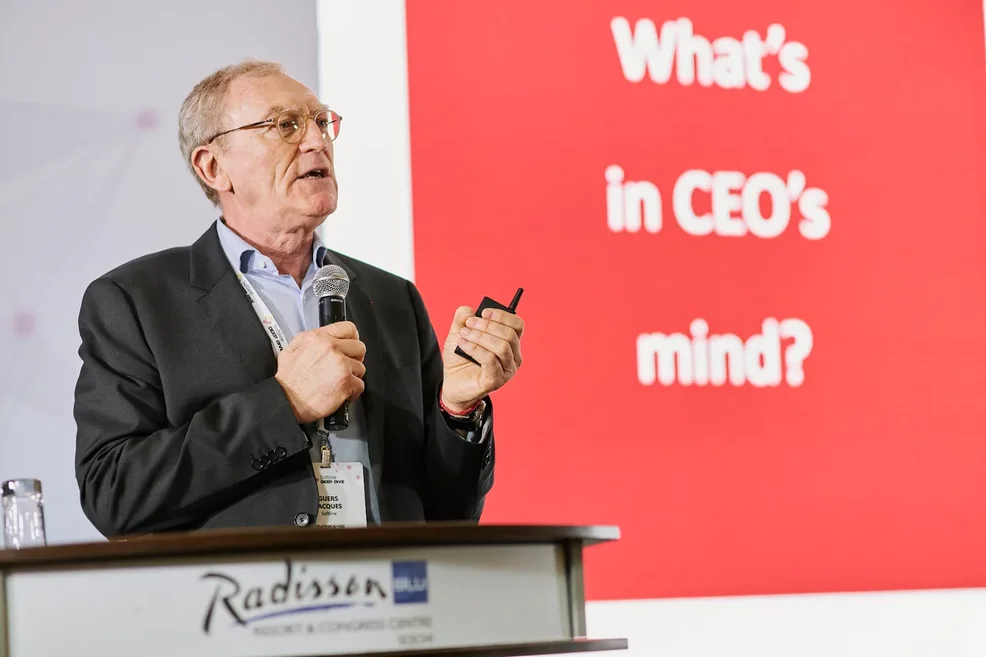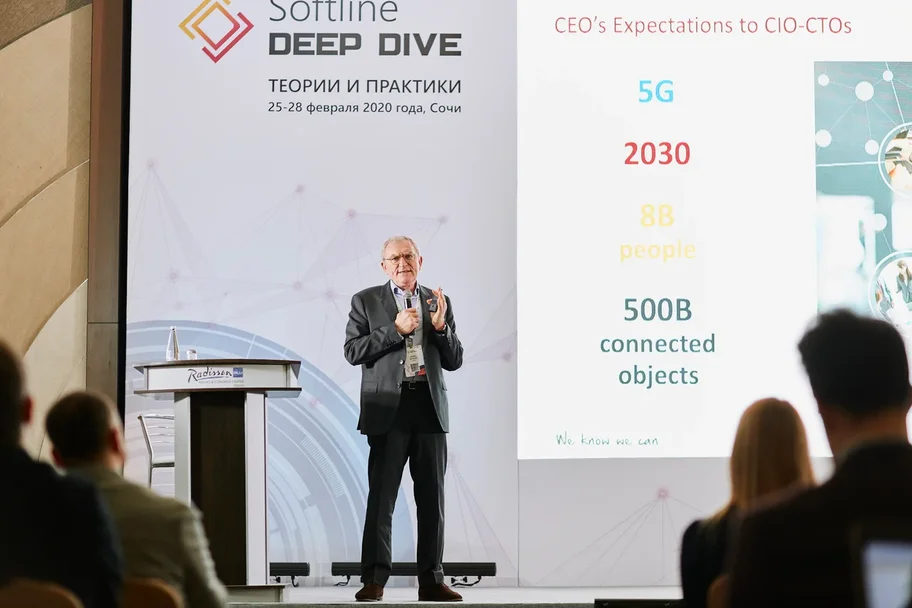Imagine yourself for a couple of minutes in a CEO's seat. What's in their head, what are their thoughts and priorities? My answer is Confidence. Confidence is priority No.1. Priorities No.2, 3 and 4 are also Confidence.
Why do I repeat word ‘confidence’ four times, you may ask? A CEO works with four different audiences and needs to convey this feeling of confidence to all of them.
Let's go back 35-40 years. I was working in sales, then moved to marketing, then I was offered to lead the sales department. I was happy, but I didn't know what it meant to be a manager, a leader. Then I was told one phrase that I have reiterated every day ever since: "A leader is a confidence dealer." This also applies to CEOs.

What four audiences do they work with? With investors—CEOs attract them. With employees—CEOs motivate them. With clients—CEOs develop the client base. And with partners—to seamlessly integrate into the partner ecosystem of other companies.
These audiences have different desires and interests. Investors expect a high return on their investment. Employees want a high salary, incentives, and career. Partners are looking to extend the cooperation, and you, in turn, want to become a recognized partner preferred to others. And of course, clients expect us to provide a high-quality solution to their problems.
These interests may seem to contradict one another. The task of a CEO is to harmonize these interests every day and to instill confidence in each of its audiences. You cannot meet the needs of two or three audiences only—all four must be satisfied at once.
No fresh news. But enough theory—let's move on to practice.
Balancing between audiences is never easy, especially in the ever-changing global situation—social instability, economic problems, geopolitical games of countries around the world, etc. It could be a currency crisis or an earthquake. Or the coronavirus. How can one instill confidence in such an unpredictable environment? It is important not only to follow the strategy but also to remain flexible in its implementation. The goal must remain the same, while the conditions of its fulfillment might change every day.
One type of unforeseen circumstance deserves a special mention—technological issues.
Some people treat them negatively, but others consider them a good thing. They can be seen as a threat to business: we have seen many companies ruined and pushed out of the market by technological failures. But we have also seen many companies that survived, reinvented, and restarted themselves.
Technological solutions, failures, disruptions, and evolution can become the core of a business. An example is Airbnb, a company founded 12 years ago. Today they manage 8 million apartments around the world. Their market capitalization is greater than that of Hilton. Tesla, which is a rather new company, today has a capitalization greater than that of Volkswagen, which produces 11 million cars annually.
What environment do we live in? 5G technology has just appeared, and now it's spreading everywhere. By 2030, 500 billion connected devices will use this infrastructure. Of course, we cannot predict the exact numbers, but it is obvious that we will live surrounded by interconnected devices, and it will impact all companies. Not just smartphones and laptops will be connected. Our refrigerators and heaters may join them. Maybe even yogurt and beer cans, as well as urban lighting systems, cars, and drones. All these elements will comprise the infrastructure of our future.
Let's look at the automotive industry as an example of business transformation. Many of us have a car. In the beginning, it is necessary to design it, then manufacture, sell, and support the customers. High-quality services should be ensured at each stage.
CAD, 3D, and many other tools are used at the design stage. But virtual crash tests and virtual aerodynamic tests are already available. Artificial intelligence and machine learning are used in car assembly processes to increase production efficiency and provide proactive technical support. Talking about sales, of course, we still apply customer acquisition strategies and sales forecasting practices. But customers have changed a lot.
People used to visit car dealerships five times before they bought a car. Today they need just one visit. The customer studies in advance the characteristics of the car they need and the price they are ready to pay. They can even configure and order a car on the Internet. Proactive CRM technologies are appearing. After-sale interactions with customers change as well.
Did you know that in early February, the coronavirus epidemic made car sales in China fall by 90%? Due to the lack of spare parts, production has also fallen in Europe. The manufacturers are closely linked, one car consists of hundreds of elements made by different companies, and to be successful in the end, you need to be confident in the quality of each part and know that all the elements are available.
Are companies ready for digital transformation? They say "yes," but often they pretend. A Gartner study shows that 71% of companies are sure that they are ready for digitalization. 66% have already started doing it. But only 10% really do the things they claim to do.
However, digital transformation is not mere modernization and optimization of business processes. Digital transformation implies radical changes. Stopping to use paper documents is called modernization. You still have scans—electronic versions of the same documents. True digital transformation is when you understand how to automate the extraction of meaningful information from all documents, regardless of their form.
But let's go back to the expectations of CEOs. My experience shows that most business owners have no idea what technology can give them. I mean, give them or take from them. Managers typically focus on short-term results and apply IT to solve urgent problems here and now.
The first requirement from the CEO is that CIOs and CTO must protect business integrity. Ensuring information security is the main task, we all know the stories about stolen customer databases, attacked websites, etc. Forget about everything else while the cybersecurity issues are not sufficiently addressed.
The second is to ensure business continuity, transparent communication between departments, simple and seamless interaction. Ensure it, and it will be easier for business to live and make progress.
However, the most important task of CIOs and CTOs (as well as CEOs, of course) is to challenge the business owners, to set tasks for them. It does not mean playing against them; it means helping to find new opportunities, open doors, new roads, use technology as a business driver.
A few years ago, when we were implementing an ERP system, I had to select the person in charge of this project. The obvious answer was "the CIO." My experience told me that the process would be painful, that the business owners would complain to me, that it would put enormous pressure on my CIO... so I made a different choice and decided that I would offer one of the owners to run the project personally. Maybe you'll ruin it, I told him, it'll be hard, but I want you to carry this load. He knew all the processes well and agreed. He took up the project and successfully completed it, after which he returned to normal duties.
This is an example of partnership, the value of which I want to convey: CIOs and CEOs should support business owners and partners and openly explain the benefits of IT that they need.
Ten years ago, when the events described above took place, we measured IT efficiency as a percentage of total revenue. That is, we treated IT as a cost. But today, we understand IT as a competitive advantage that can bring dramatic change. That's a completely different attitude.
Some years ago, discussions related to IT projects revolved around internal SLAs, estimates of resources, time, and money spent. Now the focus has shifted onto the project value, which can be obtained and delivered not only within the company but also to the business ecosystem. By the way, this fact also affects the people who are needed as C-class executives today. These are not only technically skilled specialists but also employees with developed soft skills, who think like humanitarians, who can speak the same language with anyone, especially business owners. They should be communicative people adept at negotiation and control, not just IT gurus. CIOs used to serve the company, today they contribute to and drive business transformation.
CEOs, CIOs, and CTOs are experts facing an impossible mission. On the one hand, they need to cooperate and instill confidence in four audiences. On the other hand, they have to observe the principle of zero trust in anyone. At Softline, we know what IT has to offer, and together with our customers and partners, we achieve success.










